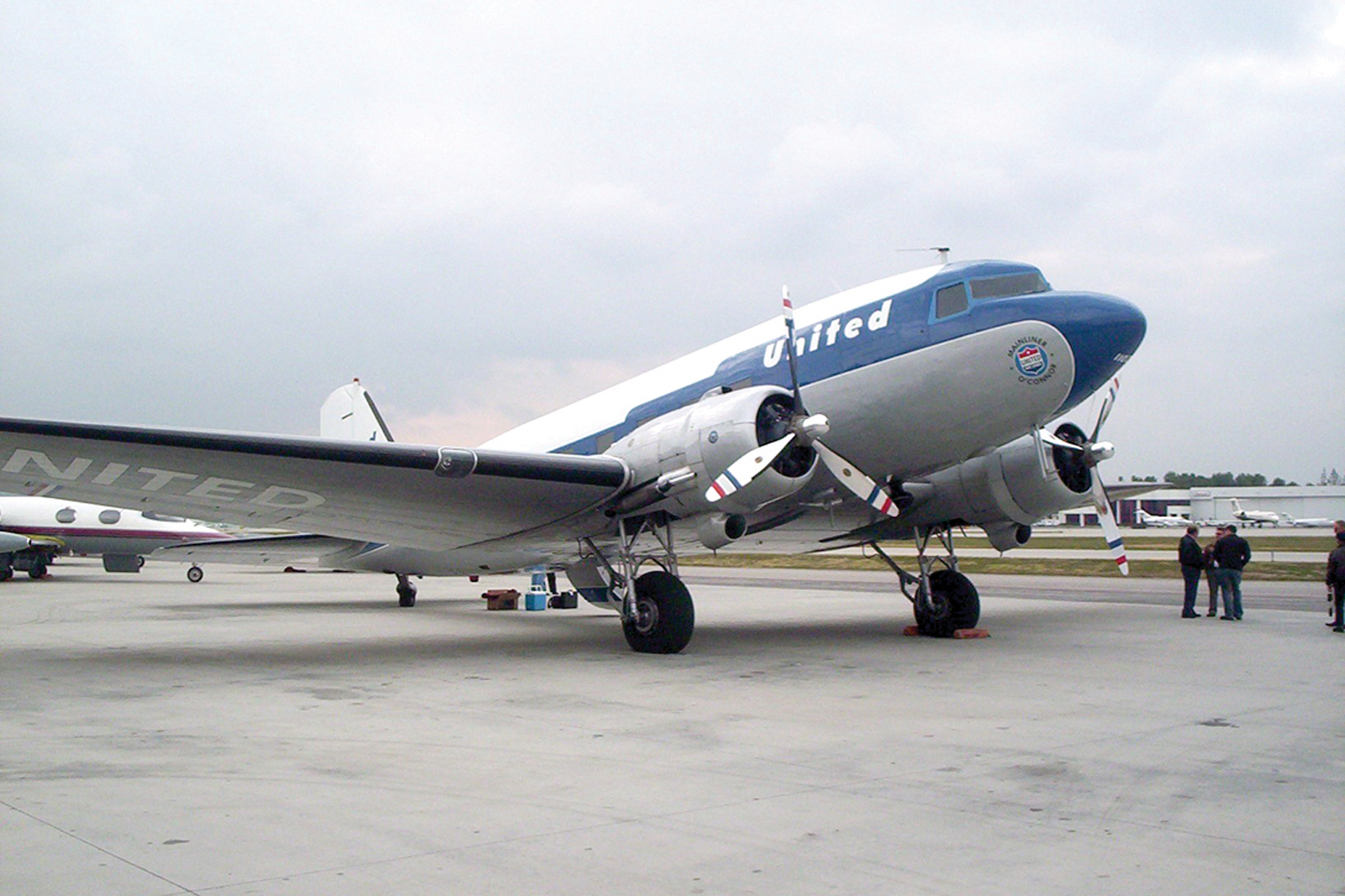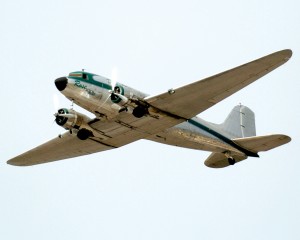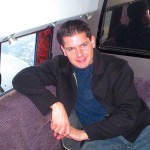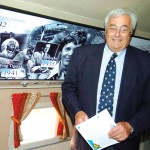By Fred “Crash” Blechman

At the request of the National Aviation Hall of Fame, Clay Lacy coordinated and led the anniversary flight in his executive DC-3, “Mainliner O’Connor.”
The Douglas DC-3 made its first flight on Dec. 17, 1935, at Santa Monica Airport, then home to Douglas Aircraft. The airplane went on to become the most popular commercial transport plane for many years. On the 70th anniversary of that first DC-3 flight, three DC-3s flew around Los Angeles and landed at Santa Monica Airport for a memorial groundbreaking ceremony and a holiday party to commemorate the day that changed the aviation world.
At the request of the National Aviation Hall of Fame, NAHF nominee Clay Lacy, founder of Clay Lacy Aviation in Van Nuys, Calif., and Seattle, coordinated and led the flight with his own DC-3. Lacy, who has logged more than 52,000 hours of flight time, flew for United Airlines for 41 years. He started with the DC-3 and ended with the Boeing 747. His executive DC-3, “Mainliner O’Connor,” is restored in the colors of United Airlines.
The second DC-3 to fly for the celebration was “Duggy,” flown by Rob Challans. Bob Odegaard, a well-known airplane collector and racing pilot, owns this bright yellow aircraft, which sports a smiley face. Odegaard loaned the plane to the National Aviation Hall of Fame, based in Dayton, Ohio, for use in its SkyReach educational program. The namesake of “Duggy” is the transport’s designer and builder, enshrinee Donald Douglas. Since its debut at Sun ‘n Fun in Lakeland, Fla., last April, “Duggy” has been traveling to air shows around the country, including EAA AirVenture Oshkosh.
John Pappas piloted “Rose,” the third DC-3 in the flight. This plane is based in Corona, Calif. Built in 1943 in Santa Monica, this DC-3 served with the 8th Air Force in Europe as a C-53 Skytrooper in World War II. It later served with several airlines before becoming an executive airplane. It was purchased by DreamFlight, Inc. ([http://www.vintageflight.com]) in 1997, and is now available for rides and events.
“Flight 70” began when the three DC-3s took off from Van Nuys Airport at 12:50 p.m. Flying in loose formation, they headed south over the Santa Monica Mountains, then off the coast over the Pacific Ocean, past Santa Monica Airport and Los Angeles International Airport. Turning inland, they flew at 500 feet over the runways of airports at Torrance, Long Beach, Fullerton, Corona, Chino, La Verne, Burbank and Pacoima. Then they headed back toward Van Nuys Airport, before flying over Santa Monica Airport, with “Duggy” in the lead, as a groundbreaking ceremony was being held.
About 300 aviation enthusiasts attended the ceremony at 2 p.m. for the Spirit of Santa Monica DC-3 Monument Park, which will be located in the center of a small park being built at the south side of the airport. A beautifully renovated DC-3, donated by David Price, warbird collector and founder of the Museum of Flying, will be mounted there on three pedestals–one under each engine and under the tail–as a special tribute to this American legend.
Bob Trimborn, Santa Monica Airport manager, emceed the ceremonies. Speakers included Price, Santa Monica Mayor Bob Holbrook and famed aerobatic pilot and NAHF enshrinee Bob Hoover.
“I think today is an historic event, not only for the DC-3, but also for Santa Monica Airport,” said Trimborn. “We broke ground for the site of the new DC-3 monument project, which will also memorialize the legend of Donald Douglas and Douglas Aircraft for generations to come.”
Ron Kaplan, the executive director of the National Aviation Hall of Fame, noted that the groundbreaking was very dramatic.
“The sky in the background was very dark, almost threatening, but the sun was beaming down on the groundbreaking,” he said. “As we were listening to the mayor speak, we heard the rumble, and low over the horizon we saw the DC-3 flight coming toward us. The mayor stopped speaking and everyone looked up. It was very poetic. It was beautiful, the sight and the sound, with the sun beaming on the airplanes as they came toward us.”
The “Spirit of Santa Monica,” the DC-3 that will be at the center of the monument park, was unveiled at a USO style hangar party co-hosted by the NAHF and the Museum of Flying, which will soon reopen at the south side of the airport. The celebration was held at the Barker Hangar on the south side of the field, near where the park and the Museum of Flying will be located. The party theme harkened back to the nostalgic era of the 1940s, with big band music and waiters in era garb.
Many well-known aviation personalities were among the more than 600 guests gathered in the large hangar. The Gregg Elliott Orchestra played the music of the 1940s and the ’40s Fly Girls sang Andrew Sisters favorites.

L to R: Bob Hoover, Buzz Aldrin and Cliff Robertson represented the National Aviation Hall of Fame at the groundbreaking for the Spirit of Santa Monica DC-3 Monument Park.
Kaplan took the opportunity to announce the four distinguished aviation figures who will be inducted into the National Aviation Hall of Fame at its 45th Annual Enshrinement Dinner & Ceremony, to be held July 15, 2006. The inductees are the late Bessie Coleman, the first black pilot licensed in the United States; Bob White, X-15 astronaut test pilot and first man to fly at Mach 4, 5 and 6; “Tex” Hill, Flying Tiger ace; and Cliff Robertson, Academy Award winning actor, pilot and lifelong advocate of general aviation.
Robertson attended the DC-3 tribute in support of the appearance of “Duggy” and the NAHF youth education program it represents. When asked what comes to mind when hearing the words “Douglas DC-3,” Robertson said he thinks about when he was a youngster.
“I was a little boy when the first DC-3 came out,” he said. “I was fascinated with the concept. Here was an airplane that would take passengers across the United States in 13 or 14 hours, and could survive economically.”
Hoover instantly thinks of the creator.
“Donald Douglas was the Henry Ford of the aviation transportation business,” he said. “We didn’t have much of an airline service until the DC-3 came along.”
Price equates the aircraft to romance, adventure and history, and recalls his own adventure in a DC-3.
“When Barron Hilton owned a DC-3, we flew to Cabo San Lucas on the day that Kennedy was assassinated,” he said. “The Mexican troops were around us with machine guns, because they thought we were (the killers) trying to escape!”
Astronaut and NAHF enshrinee Buzz Aldrin, who also attended, remarked that the DC-3 brought about the timely transformation of air transport.
“It was used so often as a transport of airborne paratroopers in World War II,” he said.
Lacy recalled that the DC-3 was the first airplane to bring profit to airlines.
“It was a reliable airplane with reliable engines,” he said. “And that was only 33 years after the Wright brothers, who had to build their own airplane and engine!”
- Brian Terwilliger, producer and director of the documentary, “One Six Right,” was a passenger on Clay Lacy’s DC-3.
- Ron Kaplan, executive director of the National Aviation Hall of Fame, exits “Duggy.”
- L to R: Clay Lacy, publicist Becki Walker and Santa Monica Airport Manager Bob Trimborn, in Lacy’s executive DC-3.
- Above: Bob Odegaard, air race pilot and owner of several warbirds, loaned “Duggy” to the NAHF for its SkyReach children’s educational program.
- L-R: The ‘40s Fly Girls, Dina, Diana and Tiffany, sang Andrew Sisters favorites.
- The Gregg Elliott Orchestra provided the music for more than 600 guests at the 1940s style party in the Barker Hangar. “The Spirit of Santa Monica,” in the background, will be featured in a new park paying tribute to the DC-3.
- James Douglas, the son of Donald Douglas, was among several family members taking part in the celebration.





















